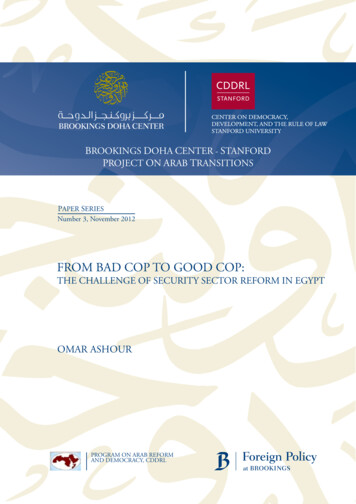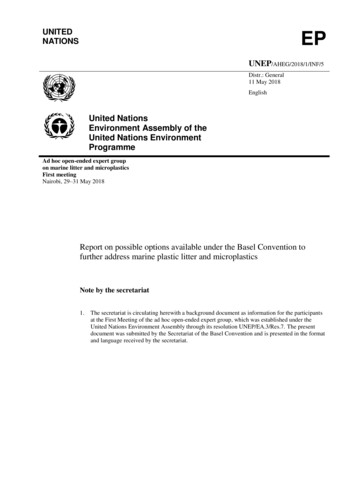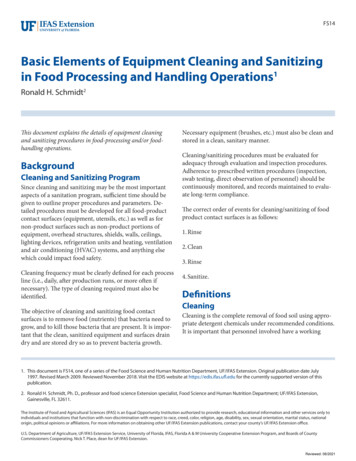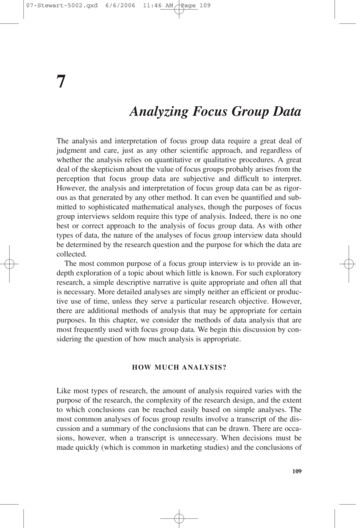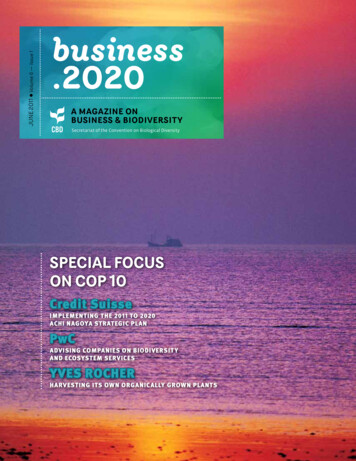
Transcription
JUNE 2011 Volume 6 — Issue 1business.2020A magazine onbusiness & biodiversitySecretariat of the Convention on Biological DiversitySpecial FocusON COP 10Credit SuisseImplementing the 2011 to 2020Achi Nagoya Strategic PlanPwCAdvising companies on Biodiversit yand ecosystem servicesYves RocherHarvesting its own organically grown plants
business.2020 / JUNE 2011business.2020Table of ContentsJUNE 2011Volume 6 — Issue 1Director of PublicationRavi Sharma, ravi.sharma@cbd.intEditorsDavid Steuerman, david.steuerman@cbd.intLars Bendik Johnsen, lars.johnsen@cbd.intMarie Aminata Khan, marie.khan@cbd.intJohan Hedlund, johan.hedlund@cbd.intLayout and DesignNatalie FletcherAdvisory committeeMr. Juan Marco AlvarezMs. Catherine CassagneMr. Saliem FakirMs. Isaura FrondiziMr. Naoya FurutaMs. Johanne GélinasMr. James GriffithsProf. Anil K. GuptaMs. Kristina JahnMr. Raji MaasriMs. Mary L. ShelmanMs. Laura van der MeerIUCNInternational Finance CorporationUniversity of StellenboschDesenvolvimento SustentavelIUCN JapanSamson Bélair / Deloitte & Touche s.e.n.c.r.l.World Business Council for Sustainable DevelopmentIndian Institute of ManagementPricewaterhouseCoopersMORES s.a.r.l.Harvard Business SchoolInternational Environmental Resources SPRLProduced with the generous financial contributionfrom the Government of the Netherlands.6Private sector efforts in Japantowards achieving Aichi Targetsby Naotake sclaimerThe designations employed and the presentation of the material in this publicationdo not imply the expression of any opinion whatsoever on the part of the Secretariatof the Convention on Biological Diversity concerning the legal status of any country,territory, city or area or of its authorities, or concerning the delimitation of its frontiersor boundaries. The views expressed in this publication are those of the authors anddo not necessarily reflect those of the Secretariat, nor does citing of trade names orcommercial processes constitute endorsement.Comments and suggestions for future columnsare welcome and should be addressed to the editor.Cover image from John Foxx/Stockbyte/Thinkstock.Secretariat of the Convention on Biological Diversity413 Rue St. Jacques, Suite 800Montréal, Québec, H2Y 1N9 CanadaTel. 1 514 288 2220 / Fax: 1 514 288 6588www.cbd.intsecretariat@cdb.int 2011 — All rights reserved.ISBN: 2-9225-385-9 (Print); 92-9225-386-7 (Web)Business 2010 - June 2011, v. 6, is. 1 - Special focus on COP 10, English30 Business supportSMART regulationby James Griffiths16Printed on Rolland Enviro100, which contains 100% recycled post-consumer fibre,is EcoLogo, Processed Chlorine Free and manufactured using biogas energy./240
business.2020 / JUNE 20114Preface25by Ahmed Djoghlaf6Private sector efforts in Japantowards achieving Aichi Targetsby Tsujimoto, Atsuo28by Naotake Okubo8Implementing the 2011-2020Aichi Nagoya Strategic PlanProtecting Vicuña andproducing high end fashion30Cemex is implementingbiodiversity action plans32Hitatchi is minimizing riskand exploring BES opportunities33PwC advices companieson sustainability35The “Great taste for the Future”campaign for biodiversity36Net Positive Impact, Rio Tinto38Petrobras will meet threebiodiversity milestones by 201540Biodiversity and EcosystemServices at Sumitomo Trustby Seiji KawazoeLIFE a new breed of certificationby Bianca Brasil42by Monica Linhares and Jane Mauro24Three different lines to buildthe business case for Biodiversityby Ivo Mulder and Jessica Boucherby Stuart Anstee22Ten principles ensuring highquality biodiversity offsetsby Kerry ten Kateby Masahide Horiuchi20Setting guidelines for thecosmetics and perfume industriesby Catherine Peyreaudby William Evison18Yves Rocher harvests itsown organically grown plantsby Claude Fromageot and Elise Rebutby Takeshi Takagi16CEBDS: Biodiversity should bemanaged as a global public assetby Marina Grossiby Vicente Saiso Alva14Business supportSMART regulationby James Griffithsby Paolo Zegna12Holcim identifies and assessimpact on Biodiversityby Rashila Tongby Ben Ridley10Oji Paper conserves forestsInnovative accountabilitymethods for biodiversityby Gaël Gonzalez44The Quebec Business and BiodiversityAssessment Project methods for biodiversityby Philippe Auzel Joel Houdet and Andrew Gonzalez/3
business.2020 / JUNE 2011/4
business.2020 / JUNE 2011Prefaceby Ahmed DjoghlafExecutive Secretary of theConvention on Biological DiversityThe tenth meeting of the Conference of the Parties (COP 10) in Nagoya,Japan was a historic meeting. Under the leadership of Japan approximately 18,500 participants attended the meeting representing, the193 Parties to the Convention, inter-governmental organizations, nongovernmental organizations, civil society organizations, UN agenciesand the business sector. We had a record number of 650 registeredbusiness organizations at COP 10.The 193 parties while adopting biodiversity targets for 2020 with a matching strategy agreed on a strongdecision to engage business in the implementation process.This edition of Business.2020 is dedicated to COP 10, giving a glimpseof the numerous events organized by the business sector in Nagoyaand ideas on how they will work to incorporate the strategy to achievethe 2020 biodiversity targets into business practices and also engagewith Governments.A new door has been opened by the CBD for business to get involved innational policy making through the revision of the National BiodiversityStrategy and Action Plan (NBSAP). The COP 10 decided to involve thebusiness community in the preparation of the NBSAP and countriesare expected to initiate this process in the coming weeks. The CBDSecretariat, through the generous financial assistance from Japan, haslaunched a number of regional and sub-regional workshops to assistcountries expedite the preparation of the NBSAPs. The list of workshopsis on the CBD website (www.cbd.int/nbsap) and representatives ofbusiness organizations are being encouraged to participate.tilateral mechanism that will operate in transboundary areas or situations where prior informed consent cannot be obtained.The Nagoya – Kuala LumpurSupplementary Protocol on Liabilit y andRedress to the Cartagena Protocol on Biosafet yPrior to COP 10, the fifth meeting of the Parties to the CartagenaProtocol on Biosafety adopted another treaty, the Nagoya – KualaLumpur Supplementary Protocol on Liability and Redress to theCartagena Protocol on Biosafety. The objective of the SupplementaryProtocol is to contribute to the conservation and sustainable use of biological diversity by providing international rules and procedures on liability and redress for damage resulting from living modified organisms(LMOs). It specifies the measures that need to be taken in responseto damage resulting from LMOs that find their origin in a transboundary movement.1 The Supplementary Protocol plays an important roleas an instrument for preventing damage on the one hand and as afurther confidence-building measure for the environmentally-sounddevelopment and application of modern biotechnology on the other.The decisions and protocols adopted in Nagoya create a level international playing field for business to incorporate biodiversity conservation into their business strategies without losing their competitive edge.COP 10 also saw a number of side events relevant to the businesssector. The International Business and Ecosystems Dialogue organizedby the World Business council for Sustainable Development (WBCSD),the International Union for Conservation of Nature (IUCN) and theKeidanren Committee on Nature Conservation (KCNC), launched theJapan Business and Biodiversity Partnership consisting of 400 companies plus government, local government and NGOs.The 2012 CBD Business and Biodiversit y Forum2020 Aichi Biodiversity TargetsShunsuke Yamamoto/Valueline/ThinkstockCOP 10 adopted 20 Aichi biodiversity targets to be achieved by year2020. These targets, organized under five strategic goals, address theunderlying causes of biodiversity loss, reducing the pressures on biodiversity, safeguarding biodiversity at all levels, enhancing the benefitsprovided by biodiversity, and providing capacity-building. Among thetargets, COP 10 agreed to: at least halve and where feasible bring closeto zero the rate of loss of natural habitats including forests; protect 17per cent of terrestrial and inland water areas and 10 per cent of marineand coastal areas; restore at least 15 percent of degraded areas; andmake special efforts to reduce the pressures faced by coral reefs.The CBD secretariat now has been mandated by COP 10 to advance theengagement of business and the road ahead is full of challenges andgreat opportunities. In this context we are looking forward to workingwith the government and the people of India as host to the Eleventhmeeting of the Conference of Parties (COP 11)to the CBD on 11 October2012. COP 11 will include a high-level session on business and biodiversity to bring together companies, business associations and policymakers from around the world to discuss ways on how to increase thenumber of good practices for conserving biodiversity. Prior to COP 11,Keidanren and the Ministry of Environment Japan plan to host a meeting to launch a global platform on business and biodiversity on 15-16December 2011 in Tokyo.Nagoya Protocol on Access and Benefit SharingIn addition, the Nagoya Protocol on Access to Genetic Resources andthe Fair and Equitable Sharing of Benefits Arising from their Utilizationwas adopted. This historic agreement creates a framework that balances access to genetic resources on the basis of prior informed consent and mutually agreed terms with the fair and equitable sharingof benefits while taking into account the important role of traditionalknowledge. The Protocol also proposes the creation of a global mul-We will keep you informed on all relevant activities through our newbusiness website, the global platform for business and biodiversity.(www.cbd.int/business ) and the Business.2020 newsletter financedby the Netherlands Government.1For more information about the Supplementary Protocol, please visit: http://bch.cbd.int/protocol/supplementary./5
business.2020 / JUNE 2011Private sector efforts in Japantowards achieving Aichi TargetsUSING THE DECL AR ATION OF BIODIVERSIT Y BY NIPPON KEIDANREN AND THE JAPAN BUSINESS ANDBIODIVERSITY PARTNERSHIP AS ITS MAIN TOOLS, AND IN COOPERATION WITH GOVERNMENTS, INTERNATIONALORGANIZ ATIONS AND NGOS HOME AND ABROAD, THE JAPANESE ECONOMIC SECTOR IS SET TO MAKECONCRETE CONTRIBUTIONS TO CONSERVING GLOBAL BIODIVERSITY AND ACHIEVING THE AICHI TARGETSby Naotake OkuboChairman, Keidanren Committee on Nature ConservationAt the tenth meeting of the Conference of the Parties (COP 10)to the Convention on Biological Diversity (CBD) held from 18 to29 October, 2010 in Nagoya, several significant agreements werereached, such as the decision on the Aichi Biodiversity Targetsas the post-2010 global targets and the adoption of the NagoyaProtocol on Access to Genetic Resources and the Fair and EquitableSharing of Benefits Arising from their Utilization to the CBD. Theseagreements made significant progress towards the achievementof the objectives of the Convention.Also at COP 10, active dialogue was held regarding the connection between business and biodiversity. Decision X/21 on businessengagement calls for support for private initiatives and global collaborations. The Keidanren Committee on Nature Conservationorganized three conferences on business engagement.At the International Business and Ecosystems Dialogue, co-hostedwith the World Business Council for Sustainable Development andIUCN, the International Union for Conservation of Nature, on 26October, topics discussed included best practices by companies,relationships with NGOs, and appropriate policies. As a result, thethree host organizations declared that they would actively engagein biodiversity conservation in collaboration with stakeholdersthrough the development of a joint statement based on the international dialogue. We also made a proposal to governments aboutthe promotion of environmental policies based on scientific factsand taking into account the rights of local communities.proximately 450 business entities and organizations have appliedto join the Partnership and we are hoping to expand. Under thispartnership, members will share information and exchange experiences with each other and with various stakeholders, includingeconomic organizations, NGOs and public organizations whichsupport private business entities’ efforts. The Partnership is aneffort in Japan that goes a step ahead of the Decision X/21, whichcalls for national initiatives on business and biodiversity.On 27 October we held a side-event on Exploring Options for aGlobal Platform on Business and Biodiversity jointly with the CBDSecretariat and IUCN. Due to its importance for the Japan Businessand Biodiversity Partnership we agreed to continue consultationsfor the establishment of a global platform for exchanging information on relevant activities, issues, and opinions, on the necessityof collaborations with organizations that share similar objectivesin each country or region.Members of the Japan Business andBiodiversity Partnership by categoryCategoryNumber or organizationBusiness entity409Economic organization16NGO15Public organization (ministryand local government etc.)10Total450(As of Mar. 1, 2011)Promoting business engagementOn the same day, we also held a ceremony to launch the JapanBusiness and Biodiversity Partnership. This program, in cooperation with the Government of Japan, aims to promote private sector business engagement in CBD implementation, i.e. conservation and sustainable use of biodiversity. The Partnership offersguidelines on specific activities by private business entities. Theseguidelines, formulated based on the Declaration of Biodiversityby Nippon Keidanren, were announced in March 2009. So far, ap/6On 28 October, the Keidanren Committee on Nature Conservation,the CBD Secretariat and the Global Environment Facility organizeda Ministerial Dialogue on Business. During this dialogue, privatesector businesses presented their biodiversity policies and requests to governments. The results of the events mentioned abovewere communicated to ministers of each country. In response tothis, Dr. Ahmed Djoghlaf, CBD Executive Secretary, expressed hishigh appreciation and gratitude for Keidanren’s efforts, such as
COURTESY OF CBDbusiness.2020 / JUNE 2011the Declaration of Nippon Keidanren on Biodiversity and the JapanBusiness and Biodiversity Partnership.Conserving biodiversityThe essence of the Declaration of Biodiversity by Nippon Keidanrenand the principle pillars of our activities are “proactive, concreteactions and collaboration.” It is more important today to promotediverse and proactive efforts by each stakeholder, as scientific dataand knowledge for evaluation in the field of biodiversity are stilllacking. Secondly, biodiversity is an issue faced by each community,thus, it is essential to promote concrete actions that contribute tobiodiversity and local communities. Verification is important in thisregard when adopting any new mechanism. Thirdly, it is importantfrom the viewpoints of complementing scientific knowledge andbusiness continuity to implement activities not only by companiesbut also in cooperation with multiple stakeholders (for example,environmental NGOs, community members, local public organizations, customers and consumers). We believe these concepts areconsistent with COP Decision X/21 and the Jakarta Charter.From now on, using the Declaration of Biodiversity by NipponKeidanren and the Japan Business and Biodiversity Partnershipas the main tools, and working in cooperation with governments,international organizations and NGOs in Japan and abroad, theeconomic sector of Japan will make concrete contributions to conserving global biodiversity and achieving the Aichi Targets. Forexample, taking into account that 2011 is the International YearUsing the Declaration of Biodiversity by Nippon Keidanrenand the Japan Business and Biodiversity Partnership as themain tools, the economic sector of Japan will make concretecontributions to achieving the Aichi Targetsof Forests, we have signed a collaborative partnership with ForestSupporters (with 600 members) comprised of groups committed tothe sustainable management of forests. In addition, we are considering holding a Japan Business and Biodiversity Partnership members meeting by the end of 2011 in cooperation with the Ministry ofEnvironment of Japan. Also, together with the CBD Secretariat, wehave started preparing for the establishment of the “global platform” which aims to promote collaboration among national partnerships like the Japan Business and Biodiversity Partnership.About the Keidanren Committee on Nature Conservation: Established in1992, is a special committee comprised of companies dedicated to theconservation of nature and biodiversity under the Nippon Keidanren(Japan Business Federation) as a comprehensive economic organization consisting of some 1,300 Japanese companies. The DecisionX/21 also refers to Nippon Keidanren. The mission of the KeidanrenCommittee on Nature Conservation is to raise funds for the KeidanrenNature Conservation Fund and review funding projects, to improvepartnership between companies and NGOs, and to raise awarenessof companies and share information./7
business.2020 / JUNE 2011Implementing the 2011-2020Aichi Nagoya Strategic PlanCREDIT SUISSE FOLLOWED DEVELOPMENTS ATCOP 10 WITH GREAT INTEREST AND IS PRESENTLYIMPLEMENTING AND PL ANNING ACTIONSC O M P L E M E N TA RY T O T H E G O A L S O F T H ESTR ATEGIC PL AN AND THE CORRESPONDINGAICHI BIODIVERSITY TARGETSby Ben RidleyRegional Head ofSustainability Affairs, Asia Pacific, Credit SuissePrior to the United Nations General Assembly designatingthe period 2011-2020 as the UN Decade of Biodiversity at theend of last year, financial institutions were increasingly becomingconscious of biodiversity conservation and the associated risksand opportunities.These risks and opportunities exist directly at Credit Suisse throughour own workplace and internal supply chain practices, and indirectly through the actions of our corporate clients – particularlyWe do not finance or advise client operations in designatedconservation areas, and we only support clients underthe principle that there are no operations located in highconservation value habitatsthose active in the primary economy, those in resource intensivesectors, those in natural resource-dependent industries, and thoseoperating near ecologically rich and sensitive areas.It was in this “risk and opportunity” context, and as a foundingsignatory of the United Nations Environment Programme FinanceInitiative (UNEP FI) and an active member of UNEP FI’s BiodiversityWork Stream, that Credit Suisse was present at the tenth meetingof the Parties (COP 10) to the Convention on Biological Diversity(CBD) in Nagoya, Japan, where we followed developments withgreat interest.COP 10 saw the launch of UNEP FI’s CEO Briefing, DemystifyingMateriality: Hardwiring biodiversity and ecosystem services intofinance, to which Credit Suisse contributed. At COP 10 we alsoengaged with Japanese financial institutions on the topic of biodiversity, sharing details of our Global Policy on Forestry and ForestProducts and on the identification and conservation of habitatsof high conservation value (HCV) through the application of ourinternal sustainability risk assessment procedures. Immediatelyfollowing COP 10, and again in partnership with UNEP FI, we leda workshop for representatives from financial institutions, majorcorporations and NGOs to broaden the dialogue on biodiversityissues management.The most important outcome of COP 10 was of course the adoptionof the revised and updated Strategic Plan for Biodiversity. CreditSuisse is currently implementing and planning other actions that are complementary to thefive Goals of the Strategic Plan andthe corresponding Aichi BiodiversityTargets for the period 2011-2020.Addressingbiodiversit y lossGoal A: To address the underlyingcauses of biodiversity loss by mainstreaming the issue. There are relatively simple actions that any organization can take to embed sustainableresource consumption into their workplace and their supply chain. At CreditiStockphoto/Thinkstock/8Credit Suisse contributed to the recent CEO Briefing onbiodiversity and ecosystem services; Credit Suisse fundingenabled recent HCV mapping across a number of forestreserves in Peninsular Malaysia, identifying sensitivehabitats such as a peat swamp
business.2020 / JUNE 2011COP 10 in picturesSuisse, some of the actions implemented several years ago includeoperating an Environmental Management System compliant withISO 14001, and procuring paper products certified by the ForestryStewardship Council (FSC). These and various other actions support the achievement of Targets 1 and 4.With respect to Goal B, and Targets 5 and 7 in particular, we donot finance or advise client operations in designated conservationareas, and we only support clients under the principle that thereare no operations located in HCV habitats – including any primarytropical moist forest habitat. Our support for sustainably managedagribusiness and forestry is demonstrated by our requirement thatall relevant client operations comply with the FSC’s Principles &Criteria (P&C) and/or are members of, and able to demonstratea roadmap towards P&C compliance with, the Roundtable onSustainable Palm Oil (RSPO). Credit Suisse became a member ofthe RSPO in 2010, when we also developed specific sustainabilityguidelines for the oil palm industry.Opening ceremony of the 10th Conference ofthe Parties in Nagoya, Japan, 18 October 2010Through our Private Banking Client Foundations Credit Suisse currently offers and aims to further expand, opportunities for philanthropic support to the field projects of global NGOs. This is justone route that we hope will support Goal C, Target 12 and theconservation of threatened habitats and species.As regards the core implementing mechanisms of capacity building and partnerships, our partnerships with conservation NGOsare very important for our organization for a number of reasons—ranging from understanding different perspectives on biodiversity risks to developing initiatives for staff and client participationand awareness-raising.In due course we will also ensure that our business activitiesare complementary to the National Biodiversity Strategies andAction Plans (NBSAPs) of our home country Switzerland, which isto be released in mid-2011 for presentation to the Swiss FederalCouncil, and to those of other countries where we have significantbusiness interests.photos courtesy of cbdTo take an example from our Asia Pacific region, our partnershipwith the conservation NGO WWF focuses on forest conservation.With our support, WWF-Malaysia recently completed HCV habitatcharacterisation of a series of tropical forest reserves in PeninsularMalaysia, which included the participation of indigenous and localcommunities. We are also funding capacity building for ongoingland-use and habitat mapping by WWF-Indonesia in the Heart ofBorneo study area in East Kalimantan. Once produced, the mapswill present an updated ecological baseline to support our sustainability risk assessment work, and will be made publically available.Closing plenary of COP-10, 29 October 2010Delegates from 193 Parties to the Convention onBiological Diversity participating in the negotiations/9
business.2020 / JUNE 2011Patrick CariouProtecting Vicuñas and producing high end fashionIntegrating sustainable development andpoverty alleviation with luxury and fashionby Paolo ZegnaChairman, Ermenegildo Zegna GroupThe slogan that accompanied the COP 10 summit in Nagoya,highlighting 2010 as the International Year of Biodiversity, wellsummarises the points that I want to address in this article, “Lifein Harmony, into the future.”As the President of one of the leading global brands in fashionand luxury I daily face the apparent contradiction between ethicsand aesthetics, between “beautiful things” and “good things”. Aconstant source of inspiration comes to me from the words ofphilosopher James Hillman, “The nature of luxury derives from theluxury of nature”1. In his essay, Hillman reflects that the first meaning of the word “luxury” is botanical and thus is why even today,with all the advances in synthetic materials, “luxury” continues toinvoke natural fibres such as cotton, linen, silk, wool, cashmereand of course the most precious of all of them, vicuña.What is vicuña?Vicuña is a natural fibre, that comes from the smallest (a vicuñaweighs about 40 kilos and stands under 90 centimetres at theshoulder) member of the Camelidae family, which includes the1J. Hillman “The Ethics of Quality”, in “Ermenegildo Zegna. An enduring passion for Fabrics,Innovation, Quality and Style”, Skira Editore, 2008 Published by Arrangement with RobertoSantachiara Literary Agency/ 10Guanaco, the Llama and the Alpaca. Vicuñas live in the wild on theslopes of the South American Andes (above 4,000 metres), withmore than half of the population concentrated in Peru. The appreciation for their unique and precious fleece dates back centuries,when Incas considered it the Fibre of Gods and its employment inthe creation of garments was a privilege reserved only for emperors. During the Inca Empire (15th Century), the number of vicuñaswas estimated to be over two million and the animals were strictlyguarded. The ritual clip of the vicuña fibre, known as chaccu2, tookplace every three to five years following precise rules and with theparticipation of hundreds of people: the animals were circled by anoisy crowd, captured, sheared and released again into the wild.Only with the advent of the European domination (16th Century),did the vicuña become an open-access resource that was huntedand slaughtered to the limit of extinction.International preservation actionBy 1960, it was estimated that the vicuña population had droppedbelow 10,000 individuals and that it was condemned to furtherdecline. Strict conservation regulations were adopted through theConvention for the Conservation of Vicuña (1969) and the entryinto force of the Convention on International Trade on EndangeredSpecies of Plants and Animals (CITES) in 1975. The first PeruvianNational Reserve, Pampa Galeras, was instituted in 1967 in theAyacucho Region. For 30 years the commercialisation of the fibrewas forbidden and the vicuña traded on the black market wasmost likely linked to poaching and coming from animals that werekilled. In the early 1990s, the Peruvian Government, assisted byCITES, laid the foundation for a sustainable and controlled use ofthe fibre. Local communities were given animals as their nationalright and could legally count on the revenues of their shearing, as2Literally “round up”
business.2020 / JUNE 2011long as they protected vicuñas from poaching. A modern type ofchaccu was introduced, guaranteeing an ethical, respectful biennialharvest of the fibre. In 1994, the International Vicuña Consortium(IVC), comprised of three companies, received the first authorisation of legal trade of the vicuña coming from Peruvian communities.How did Zegna become involved?Our direct involvement in the sourcing of the precious vicuña began in 1999, when the Zegna Group absorbed the Italian luxurywomenswear brand Agnona, one of the three founders of the IVC,and the latest example of our long experience in natural fibres.The creation of a direct relationship with woolgrowers of the finest fibres around the world has, in fact, for half a century been thetrademark of the Lanificio (wool mill) Zegna, that was founded in1910 and still operates in Trivero in the Italian Alps. In 1963, myfather and my uncle instituted the first edition of the Extrafine WoolTrophy in Australia to stimulate and financially support local farmers who engaged in constantly improving the quality of their wool.As a result, the Lanificio Zegna was to pioneer and première onthe international market fabrics unique for both their performanceand their style.The introduction of lightweight wool fabrics which are pleasant towear even in warm climates, was a real revolution and invented theconcept of the trans-seasonal suit. The internationally renownedZegna Wool Trophies were followed by the Mohair Trophy in SouthAfrica (1970) and the Cashmere Trophy in Inner Mongolia (1985),which were only exceeded in fame by the Ermenegildo Zegna VellusAureum (2002), the worldwide competition awarding the finestfleece of merino wool. The history of the Zegna Trophies is a storyof mutual appreciation and close collaboration with local producers, who understood that their only chance in a global market wasto protect their natural resources and to invest to improve theirquality. The recent addition of the vicuña to our long experience inraw materials has brought enormous satisfaction on both a commercial and ethical level. The reappearance of the vicuña on theinternational market, free of any moral concern, was greeted withenthusiasm by our customers. In July 2002, even the last international concern was overcome when the US Fish & Wildlife Serviceremoved the vicuña from its endangered species list. The 2007Vicuña Convention estimated the Peruvian vicuña population tobe around 190,000 individuals.rainy season between November and March, followed by monthsof drought and temperatures that can drop below –20 C.Fondazione Zegna, the Group’s non profit organisationwhose aim it is to offer a better quality of life to individuals bycasting the foundations for their autonomous development, decided on a project that would bring water infrastructures to thecommunity. We are currently in the middle of a three-ye
business organizations at COP 10.The 193 parties while adopting bio-diversity targets for 2020 with a matching strategy agreed on a strong decision to engage business in the implementation process. This edition of Business.2020 is dedicated to COP 10, giving a glimpse of the n

